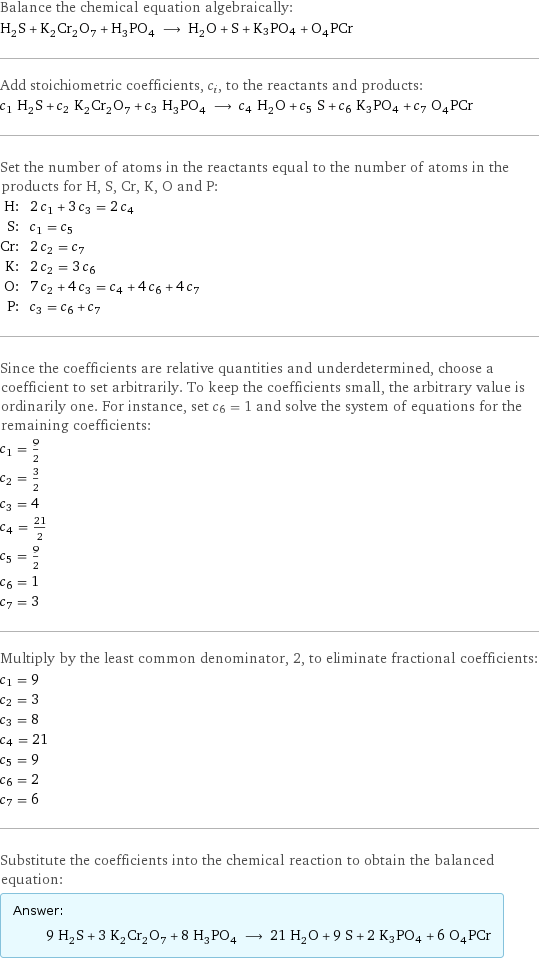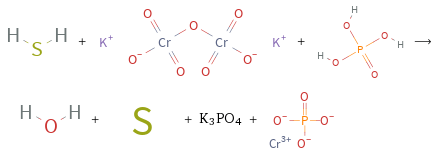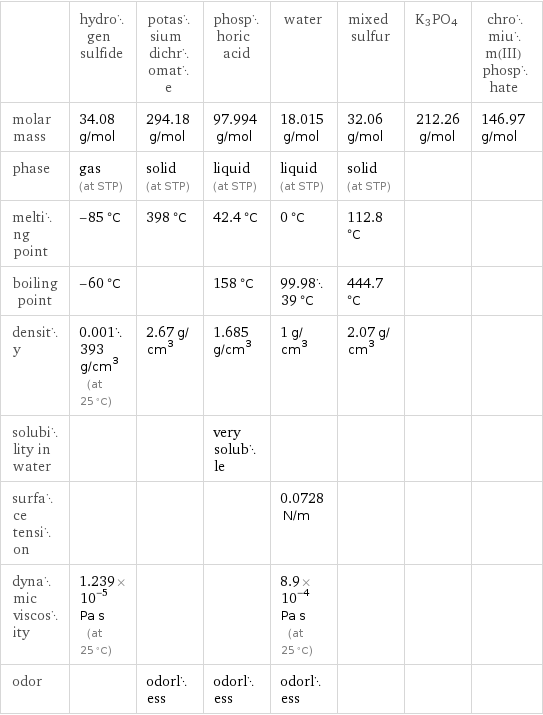Input interpretation

H_2S hydrogen sulfide + K_2Cr_2O_7 potassium dichromate + H_3PO_4 phosphoric acid ⟶ H_2O water + S mixed sulfur + K3PO4 + O_4PCr chromium(III) phosphate
Balanced equation

Balance the chemical equation algebraically: H_2S + K_2Cr_2O_7 + H_3PO_4 ⟶ H_2O + S + K3PO4 + O_4PCr Add stoichiometric coefficients, c_i, to the reactants and products: c_1 H_2S + c_2 K_2Cr_2O_7 + c_3 H_3PO_4 ⟶ c_4 H_2O + c_5 S + c_6 K3PO4 + c_7 O_4PCr Set the number of atoms in the reactants equal to the number of atoms in the products for H, S, Cr, K, O and P: H: | 2 c_1 + 3 c_3 = 2 c_4 S: | c_1 = c_5 Cr: | 2 c_2 = c_7 K: | 2 c_2 = 3 c_6 O: | 7 c_2 + 4 c_3 = c_4 + 4 c_6 + 4 c_7 P: | c_3 = c_6 + c_7 Since the coefficients are relative quantities and underdetermined, choose a coefficient to set arbitrarily. To keep the coefficients small, the arbitrary value is ordinarily one. For instance, set c_6 = 1 and solve the system of equations for the remaining coefficients: c_1 = 9/2 c_2 = 3/2 c_3 = 4 c_4 = 21/2 c_5 = 9/2 c_6 = 1 c_7 = 3 Multiply by the least common denominator, 2, to eliminate fractional coefficients: c_1 = 9 c_2 = 3 c_3 = 8 c_4 = 21 c_5 = 9 c_6 = 2 c_7 = 6 Substitute the coefficients into the chemical reaction to obtain the balanced equation: Answer: | | 9 H_2S + 3 K_2Cr_2O_7 + 8 H_3PO_4 ⟶ 21 H_2O + 9 S + 2 K3PO4 + 6 O_4PCr
Structures

+ + ⟶ + + K3PO4 +
Names

hydrogen sulfide + potassium dichromate + phosphoric acid ⟶ water + mixed sulfur + K3PO4 + chromium(III) phosphate
Equilibrium constant
![Construct the equilibrium constant, K, expression for: H_2S + K_2Cr_2O_7 + H_3PO_4 ⟶ H_2O + S + K3PO4 + O_4PCr Plan: • Balance the chemical equation. • Determine the stoichiometric numbers. • Assemble the activity expression for each chemical species. • Use the activity expressions to build the equilibrium constant expression. Write the balanced chemical equation: 9 H_2S + 3 K_2Cr_2O_7 + 8 H_3PO_4 ⟶ 21 H_2O + 9 S + 2 K3PO4 + 6 O_4PCr Assign stoichiometric numbers, ν_i, using the stoichiometric coefficients, c_i, from the balanced chemical equation in the following manner: ν_i = -c_i for reactants and ν_i = c_i for products: chemical species | c_i | ν_i H_2S | 9 | -9 K_2Cr_2O_7 | 3 | -3 H_3PO_4 | 8 | -8 H_2O | 21 | 21 S | 9 | 9 K3PO4 | 2 | 2 O_4PCr | 6 | 6 Assemble the activity expressions accounting for the state of matter and ν_i: chemical species | c_i | ν_i | activity expression H_2S | 9 | -9 | ([H2S])^(-9) K_2Cr_2O_7 | 3 | -3 | ([K2Cr2O7])^(-3) H_3PO_4 | 8 | -8 | ([H3PO4])^(-8) H_2O | 21 | 21 | ([H2O])^21 S | 9 | 9 | ([S])^9 K3PO4 | 2 | 2 | ([K3PO4])^2 O_4PCr | 6 | 6 | ([O4P1Cr1])^6 The equilibrium constant symbol in the concentration basis is: K_c Mulitply the activity expressions to arrive at the K_c expression: Answer: | | K_c = ([H2S])^(-9) ([K2Cr2O7])^(-3) ([H3PO4])^(-8) ([H2O])^21 ([S])^9 ([K3PO4])^2 ([O4P1Cr1])^6 = (([H2O])^21 ([S])^9 ([K3PO4])^2 ([O4P1Cr1])^6)/(([H2S])^9 ([K2Cr2O7])^3 ([H3PO4])^8)](../image_source/5b1baaf6044237358546bc825d349b28.png)
Construct the equilibrium constant, K, expression for: H_2S + K_2Cr_2O_7 + H_3PO_4 ⟶ H_2O + S + K3PO4 + O_4PCr Plan: • Balance the chemical equation. • Determine the stoichiometric numbers. • Assemble the activity expression for each chemical species. • Use the activity expressions to build the equilibrium constant expression. Write the balanced chemical equation: 9 H_2S + 3 K_2Cr_2O_7 + 8 H_3PO_4 ⟶ 21 H_2O + 9 S + 2 K3PO4 + 6 O_4PCr Assign stoichiometric numbers, ν_i, using the stoichiometric coefficients, c_i, from the balanced chemical equation in the following manner: ν_i = -c_i for reactants and ν_i = c_i for products: chemical species | c_i | ν_i H_2S | 9 | -9 K_2Cr_2O_7 | 3 | -3 H_3PO_4 | 8 | -8 H_2O | 21 | 21 S | 9 | 9 K3PO4 | 2 | 2 O_4PCr | 6 | 6 Assemble the activity expressions accounting for the state of matter and ν_i: chemical species | c_i | ν_i | activity expression H_2S | 9 | -9 | ([H2S])^(-9) K_2Cr_2O_7 | 3 | -3 | ([K2Cr2O7])^(-3) H_3PO_4 | 8 | -8 | ([H3PO4])^(-8) H_2O | 21 | 21 | ([H2O])^21 S | 9 | 9 | ([S])^9 K3PO4 | 2 | 2 | ([K3PO4])^2 O_4PCr | 6 | 6 | ([O4P1Cr1])^6 The equilibrium constant symbol in the concentration basis is: K_c Mulitply the activity expressions to arrive at the K_c expression: Answer: | | K_c = ([H2S])^(-9) ([K2Cr2O7])^(-3) ([H3PO4])^(-8) ([H2O])^21 ([S])^9 ([K3PO4])^2 ([O4P1Cr1])^6 = (([H2O])^21 ([S])^9 ([K3PO4])^2 ([O4P1Cr1])^6)/(([H2S])^9 ([K2Cr2O7])^3 ([H3PO4])^8)
Rate of reaction
![Construct the rate of reaction expression for: H_2S + K_2Cr_2O_7 + H_3PO_4 ⟶ H_2O + S + K3PO4 + O_4PCr Plan: • Balance the chemical equation. • Determine the stoichiometric numbers. • Assemble the rate term for each chemical species. • Write the rate of reaction expression. Write the balanced chemical equation: 9 H_2S + 3 K_2Cr_2O_7 + 8 H_3PO_4 ⟶ 21 H_2O + 9 S + 2 K3PO4 + 6 O_4PCr Assign stoichiometric numbers, ν_i, using the stoichiometric coefficients, c_i, from the balanced chemical equation in the following manner: ν_i = -c_i for reactants and ν_i = c_i for products: chemical species | c_i | ν_i H_2S | 9 | -9 K_2Cr_2O_7 | 3 | -3 H_3PO_4 | 8 | -8 H_2O | 21 | 21 S | 9 | 9 K3PO4 | 2 | 2 O_4PCr | 6 | 6 The rate term for each chemical species, B_i, is 1/ν_i(Δ[B_i])/(Δt) where [B_i] is the amount concentration and t is time: chemical species | c_i | ν_i | rate term H_2S | 9 | -9 | -1/9 (Δ[H2S])/(Δt) K_2Cr_2O_7 | 3 | -3 | -1/3 (Δ[K2Cr2O7])/(Δt) H_3PO_4 | 8 | -8 | -1/8 (Δ[H3PO4])/(Δt) H_2O | 21 | 21 | 1/21 (Δ[H2O])/(Δt) S | 9 | 9 | 1/9 (Δ[S])/(Δt) K3PO4 | 2 | 2 | 1/2 (Δ[K3PO4])/(Δt) O_4PCr | 6 | 6 | 1/6 (Δ[O4P1Cr1])/(Δt) (for infinitesimal rate of change, replace Δ with d) Set the rate terms equal to each other to arrive at the rate expression: Answer: | | rate = -1/9 (Δ[H2S])/(Δt) = -1/3 (Δ[K2Cr2O7])/(Δt) = -1/8 (Δ[H3PO4])/(Δt) = 1/21 (Δ[H2O])/(Δt) = 1/9 (Δ[S])/(Δt) = 1/2 (Δ[K3PO4])/(Δt) = 1/6 (Δ[O4P1Cr1])/(Δt) (assuming constant volume and no accumulation of intermediates or side products)](../image_source/f9f2b5830a59bac91cea68c607380cc1.png)
Construct the rate of reaction expression for: H_2S + K_2Cr_2O_7 + H_3PO_4 ⟶ H_2O + S + K3PO4 + O_4PCr Plan: • Balance the chemical equation. • Determine the stoichiometric numbers. • Assemble the rate term for each chemical species. • Write the rate of reaction expression. Write the balanced chemical equation: 9 H_2S + 3 K_2Cr_2O_7 + 8 H_3PO_4 ⟶ 21 H_2O + 9 S + 2 K3PO4 + 6 O_4PCr Assign stoichiometric numbers, ν_i, using the stoichiometric coefficients, c_i, from the balanced chemical equation in the following manner: ν_i = -c_i for reactants and ν_i = c_i for products: chemical species | c_i | ν_i H_2S | 9 | -9 K_2Cr_2O_7 | 3 | -3 H_3PO_4 | 8 | -8 H_2O | 21 | 21 S | 9 | 9 K3PO4 | 2 | 2 O_4PCr | 6 | 6 The rate term for each chemical species, B_i, is 1/ν_i(Δ[B_i])/(Δt) where [B_i] is the amount concentration and t is time: chemical species | c_i | ν_i | rate term H_2S | 9 | -9 | -1/9 (Δ[H2S])/(Δt) K_2Cr_2O_7 | 3 | -3 | -1/3 (Δ[K2Cr2O7])/(Δt) H_3PO_4 | 8 | -8 | -1/8 (Δ[H3PO4])/(Δt) H_2O | 21 | 21 | 1/21 (Δ[H2O])/(Δt) S | 9 | 9 | 1/9 (Δ[S])/(Δt) K3PO4 | 2 | 2 | 1/2 (Δ[K3PO4])/(Δt) O_4PCr | 6 | 6 | 1/6 (Δ[O4P1Cr1])/(Δt) (for infinitesimal rate of change, replace Δ with d) Set the rate terms equal to each other to arrive at the rate expression: Answer: | | rate = -1/9 (Δ[H2S])/(Δt) = -1/3 (Δ[K2Cr2O7])/(Δt) = -1/8 (Δ[H3PO4])/(Δt) = 1/21 (Δ[H2O])/(Δt) = 1/9 (Δ[S])/(Δt) = 1/2 (Δ[K3PO4])/(Δt) = 1/6 (Δ[O4P1Cr1])/(Δt) (assuming constant volume and no accumulation of intermediates or side products)
Chemical names and formulas

| hydrogen sulfide | potassium dichromate | phosphoric acid | water | mixed sulfur | K3PO4 | chromium(III) phosphate formula | H_2S | K_2Cr_2O_7 | H_3PO_4 | H_2O | S | K3PO4 | O_4PCr Hill formula | H_2S | Cr_2K_2O_7 | H_3O_4P | H_2O | S | K3O4P | CrO_4P name | hydrogen sulfide | potassium dichromate | phosphoric acid | water | mixed sulfur | | chromium(III) phosphate IUPAC name | hydrogen sulfide | dipotassium oxido-(oxido-dioxochromio)oxy-dioxochromium | phosphoric acid | water | sulfur | | chromium(3+) phosphate
Substance properties

| hydrogen sulfide | potassium dichromate | phosphoric acid | water | mixed sulfur | K3PO4 | chromium(III) phosphate molar mass | 34.08 g/mol | 294.18 g/mol | 97.994 g/mol | 18.015 g/mol | 32.06 g/mol | 212.26 g/mol | 146.97 g/mol phase | gas (at STP) | solid (at STP) | liquid (at STP) | liquid (at STP) | solid (at STP) | | melting point | -85 °C | 398 °C | 42.4 °C | 0 °C | 112.8 °C | | boiling point | -60 °C | | 158 °C | 99.9839 °C | 444.7 °C | | density | 0.001393 g/cm^3 (at 25 °C) | 2.67 g/cm^3 | 1.685 g/cm^3 | 1 g/cm^3 | 2.07 g/cm^3 | | solubility in water | | | very soluble | | | | surface tension | | | | 0.0728 N/m | | | dynamic viscosity | 1.239×10^-5 Pa s (at 25 °C) | | | 8.9×10^-4 Pa s (at 25 °C) | | | odor | | odorless | odorless | odorless | | |
Units
